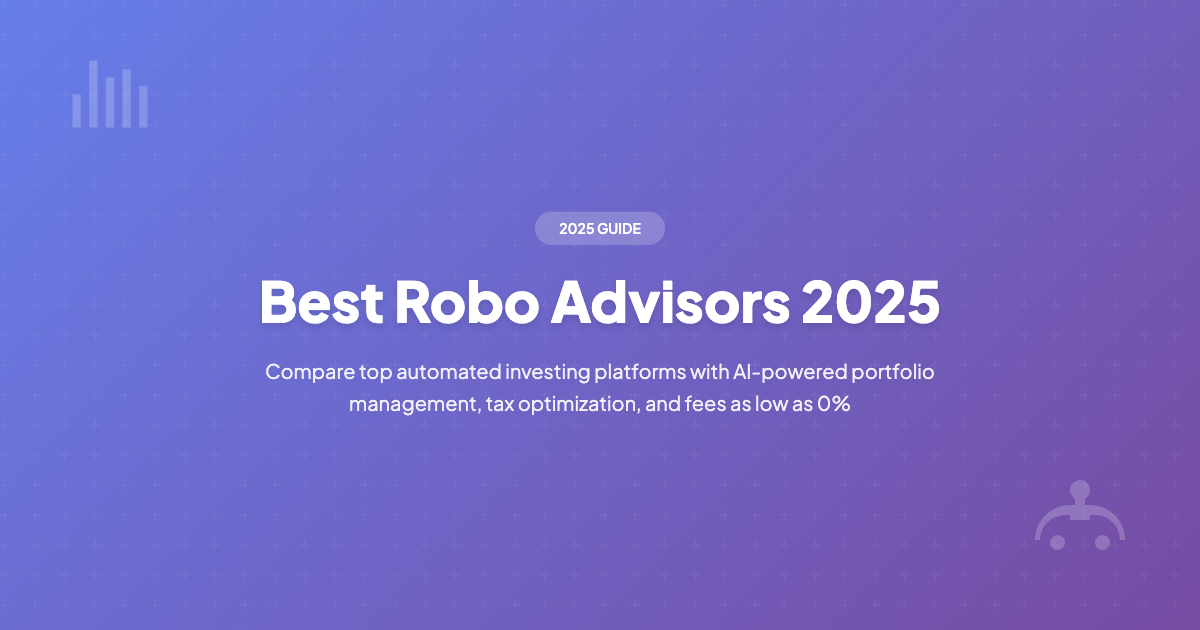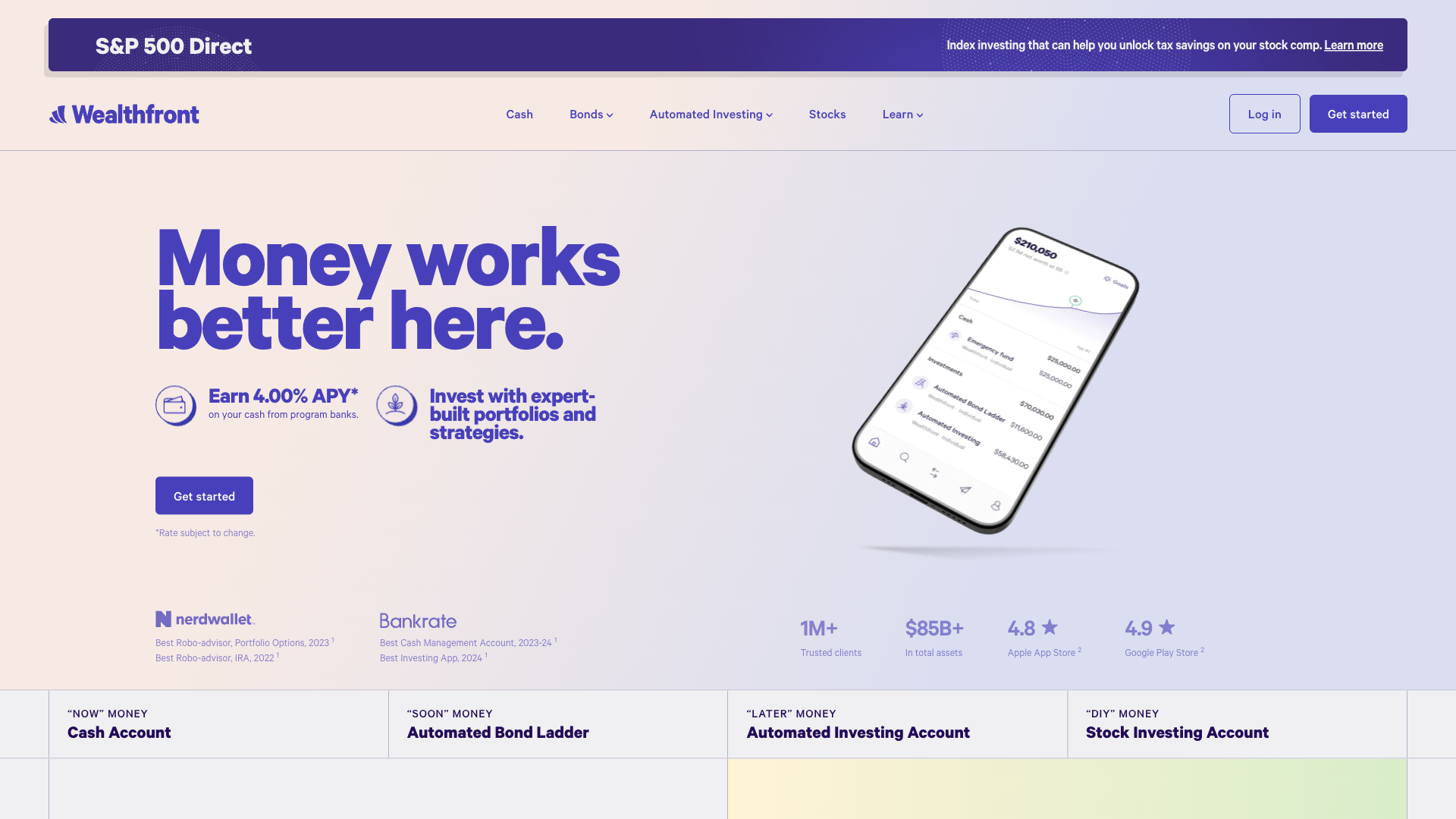
Key Takeaways
- Wealthfront leads with advanced tax optimization and direct indexing at 0.25% annual fee
- Betterment offers $0 minimum and human advisor access with Premium tier
- Vanguard Digital Advisor provides lowest costs at just $100 minimum investment
- Fidelity Go charges no fees on balances under $25,000
- Most platforms now offer fractional shares and ESG investing options
What are robo advisors and how do they transform investing in 2025?
The robo advisor revolution has fundamentally changed how Americans invest. According to Statista's 2025 Robo Advisory Report, the market has grown to $1.8 trillion in assets under management, with over 25 million users actively investing through automated platforms.
These platforms leverage sophisticated algorithms and artificial intelligence to create and manage diversified portfolios tailored to individual risk tolerance and financial goals. What once required expensive human advisors charging 1-2% annually can now be accomplished for as little as 0.25% – or even free in some cases. For context on broader investment options, explore our investment platform reviews.
Which robo advisors offer the best features and value in 2025?

1. Wealthfront - Best for Tax Optimization
Leading Morningstar's 2025 rankings, Wealthfront has perfected the art of tax-efficient investing. Their sophisticated tax-loss harvesting saved users an average of $4,200 annually on accounts over $100,000, according to their latest impact report.
Key Benefits:
- 0.25% annual advisory fee with $500 minimum investment
- Daily tax-loss harvesting on all taxable accounts
- Direct indexing for accounts over $100,000
- Path financial planning tool answers 10,000+ scenarios
- New S&P 500 Direct portfolio at just 0.09% fee
- Automated rebalancing across all accounts
Annual Fee: 0.25%

2. Betterment - Best for Beginners
With no minimum investment requirement and intuitive goal-based planning tools, Betterment has democratized investing for over 850,000 users. Their 2025 Investment Strategy Guide shows how their dynamic rebalancing outperformed static portfolios by 2.4% annually.
Key Benefits:
- $0 minimum investment ($10 to start investing)
- 0.25% fee for digital-only service
- Premium tier at 0.65% includes unlimited CFP® access
- Goal-based investment tracking and advice
- Crypto portfolio option available
- Socially responsible investing portfolios
Annual Fee: 0.25% (Digital) / 0.65% (Premium)

3. Vanguard Digital Advisor - Best Low-Cost Option
True to Vanguard's philosophy, their Digital Advisor combines rock-bottom fees with access to their legendary low-cost ETFs. After reducing minimums to $100 in 2024, they've seen explosive growth, now managing over $250 billion according to Vanguard's fund reports.
Key Benefits:
- Just $100 minimum investment (reduced from $3,000)
- 0.20% annual advisory fee
- Access to Vanguard's ultra-low-cost ETFs
- Automatic rebalancing and dividend reinvestment
- Goal tracking and retirement planning tools
- No account service fees
Annual Fee: 0.20%

4. Schwab Intelligent Portfolios - Best No-Fee Option
Schwab disrupted the robo advisor space by eliminating advisory fees entirely. While they require a higher $5,000 minimum and mandate a cash allocation, the zero-fee structure has attracted over $80 billion in assets. Their performance data shows competitive returns despite the cash drag.
Key Benefits:
- $0 advisory fees (no management fee)
- $5,000 minimum investment
- Automatic rebalancing and tax-loss harvesting
- 24/7 customer service
- Premium version with CFP® guidance at $30/month
- Bank sweep feature for cash allocation
Annual Fee: $0 (requires cash allocation)
5. Fidelity Go - Best for Small Accounts
Fidelity's robo advisor stands out by waiving all fees on accounts under $25,000, making it ideal for young investors. Integrated with Fidelity's broader ecosystem, users benefit from comprehensive financial tools and research. Fidelity's analysis shows their zero-expense-ratio funds save investors 0.35% annually versus competitor funds.
Key Benefits:
- Free management for balances under $25,000
- 0.35% fee for larger accounts
- No minimum investment requirement
- Proprietary zero-expense-ratio Fidelity Flex funds
- Integration with Fidelity's full platform
- Personalized planning and coaching available
Annual Fee: 0% (under $25k) / 0.35% (over $25k)
How do modern robo advisors use AI and technology?
The integration of artificial intelligence has transformed robo advisors from simple rebalancing tools into sophisticated wealth management platforms. According to McKinsey's 2025 FinTech Report, AI-enhanced robo advisors now outperform traditional portfolios by an average of 1.8% annually through superior tax optimization and timing.
Key Technological Advances
- Predictive Analytics: ML models predict market movements and optimize rebalancing timing
- Natural Language Processing: Chatbots provide 24/7 financial planning guidance
- Computer Vision: Document scanning for automated account transfers
- Behavioral Analysis: AI tracks spending patterns to optimize savings rates
What investment strategies do robo advisors employ?
Understanding how robo advisors invest your money is crucial for setting proper expectations. Most platforms follow established investment principles while adding proprietary optimizations.
Core Investment Strategies
Strategy Comparison
| Strategy | Description | Best For | Platforms |
|---|---|---|---|
| Modern Portfolio Theory | Diversified ETF allocation | Most investors | All platforms |
| Direct Indexing | Own individual stocks | High net worth | Wealthfront, Schwab |
| Factor Investing | Tilt toward value/momentum | Long-term growth | Betterment, Wealthfront |
| Tax-Loss Harvesting | Sell losers for tax benefits | Taxable accounts | Most platforms |
| ESG Investing | Sustainable companies only | Values-based investors | Betterment, Wealthfront |
How much can you save with robo advisors versus traditional advisors?
The cost advantage of robo advisors becomes clear when examining real numbers. Traditional financial advisors typically charge 1-2% of assets under management, while robo advisors average just 0.25%. Let's examine the long-term impact:
20-Year Cost Comparison ($100,000 Initial Investment)
- Traditional Advisor (1.5% fee): $124,000 in fees
- Robo Advisor (0.25% fee): $26,000 in fees
- Difference: $98,000 more in your pocket
These calculations assume 7% annual returns and don't include the additional benefits of tax-loss harvesting, which Vanguard research shows can add 0.5-1% in annual after-tax returns.
Who should use robo advisors versus human advisors?
Ideal Robo Advisor Candidates
- Young professionals building wealth
- Cost-conscious investors
- Those with simple investment needs
- Tech-savvy individuals preferring digital tools
- Investors seeking passive, hands-off management
When Human Advisors Add Value
- Complex tax situations or business ownership
- Estate planning needs
- Emotional support during market downturns
- Coordination with other professionals (CPAs, attorneys)
- High net worth requiring sophisticated strategies
What are the risks and limitations of robo advisors?
Despite their advantages, robo advisors aren't perfect for everyone. Understanding their limitations helps set realistic expectations:
Key Limitations
- Limited Customization: Algorithms can't handle unique situations like concentrated stock positions or complex trusts
- No Behavioral Coaching: During the 2020 crash, Morningstar found robo advisor users were more likely to panic sell
- Tax Strategy Gaps: Can't coordinate with outside accounts or implement sophisticated strategies
- Communication Limits: Chatbots can't replace nuanced financial conversations
- One-Size-Fits-Most: May not optimize for individual circumstances
How to choose the right robo advisor for your needs?
Follow this decision framework to select the best robo advisor:
1. Determine Your Investment Amount
- Under $25,000: Consider Fidelity Go (free management)
- $25,000-$100,000: Betterment or Wealthfront offer best features
- Over $100,000: Wealthfront's direct indexing provides tax advantages
2. Identify Key Priorities
- Lowest Fees: Vanguard Digital Advisor or Schwab
- Tax Optimization: Wealthfront leads the pack
- Human Advisor Access: Betterment Premium
- Brand Trust: Vanguard or Fidelity
3. Evaluate Platform Features
Compare must-have features like mobile apps, goal planning tools, account types offered, and integration with existing accounts. For broader financial planning needs, explore our banking and credit card resources.
What's the future of robo advisors?
The robo advisor industry continues rapid evolution. Statista projects the global robo advisor market will reach $5.9 trillion by 2030, driven by these emerging trends:
Emerging Trends for 2025-2030
- Cryptocurrency Integration: Major platforms adding Bitcoin and Ethereum allocation options
- Alternative Investments: Access to real estate, commodities, and private equity
- Hyper-Personalization: AI analyzing spending patterns for custom strategies
- Consolidated Finance: Single platforms managing investing, banking, and lending
- Voice-Activated Investing: Managing portfolios through Alexa and Google Assistant
Conclusion
Robo advisors have democratized professional investment management, making sophisticated strategies accessible to everyone. While Wealthfront leads in tax optimization and Betterment excels for beginners, the best choice depends on your specific needs and priorities.
As these platforms continue evolving with AI advancements and expanded features, they're becoming increasingly difficult to ignore – even for wealthy investors who can afford human advisors. With fees 75% lower than traditional management and growing sophistication, robo advisors represent the future of investing for millions of Americans.
Ready to start automated investing? Compare options at our investment platform reviews or explore more financial guides to optimize your complete financial picture.